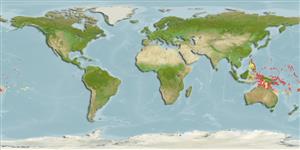Common names from other countries
>
Eupercaria/misc (Various families in series Eupercaria) >
Lutjanidae (Snappers) > Lutjaninae
Etymology: Lutjanus: Malay, ikan lutjan, name of a fish.
More on authors: Quoy & Gaimard.
Issue
Type locality: Rawak; Waigiu.
Environment: milieu / climate zone / depth range / distribution range
Ecologia
marinhas associadas(os) a recifes; intervalo de profundidade 0 - 36 m (Ref. 9710). Tropical; 20°N - 26°S, 118°E - 146°W (Ref. 55)
Western Pacific: mainly southern Oceania from Tahiti to New Guinea, and extending northward to the Philippines. Uncommon except in the Caroline Islands (Ref. 9710).
Tamanho / Peso / Idade
Maturity: Lm ? range ? - ? cm
Max length : 35.0 cm TL macho/indeterminado; (Ref. 55); common length : 20.0 cm TL macho/indeterminado; (Ref. 55)
Espinhos dorsais (total) : 10; Raios dorsais moles (total) : 13; Espinhos anais: 3; Raios anais moles: 8 - 9. Dorsal profile of head moderately sloped. Preorbital width about equal to eye diameter or slightly greater. Preopercular notch and knob poorly developed. Scale rows on back rising obliquely above lateral line. Generally pink, grading to white on lower half of the body. A series of seven narrow brown bars extend from the back to about half way down the side. A big black blotch is on the peduncle and the adjacent caudal-fin base (Ref. 469). Body depth 2.6-3.1 in SL (Ref. 90102).
Adults inhabit coral reefs where it usually occurs singly or in small groups. A shy species that moves around quickly through coral channels in hunt for small fishes (Ref. 48635). Minimum depth reported taken from Ref. 128797.
Life cycle and mating behavior
Maturities | Reprodução | Spawnings | Egg(s) | Fecundities | Larvas
Allen, G.R., 1985. FAO Species Catalogue. Vol. 6. Snappers of the world. An annotated and illustrated catalogue of lutjanid species known to date. FAO Fish. Synop. 125(6):208 p. Rome: FAO. (Ref. 55)
Categoria na Lista Vermelha da IUCN (Ref. 130435)
CITES (Ref. 128078)
Not Evaluated
Ameaça para o homem
Harmless
Utilização humana
Pescarias: pouco comercial
Ferramentas
Relatórios especiais
Descarregue XML
Fontes da internet
Estimates based on models
Preferred temperature (Ref.
115969): 26.4 - 28.9, mean 28 (based on 154 cells).
Phylogenetic diversity index (Ref.
82804): PD
50 = 0.5000 [Uniqueness, from 0.5 = low to 2.0 = high].
Bayesian length-weight: a=0.01288 (0.00736 - 0.02254), b=3.03 (2.89 - 3.17), in cm Total Length, based on LWR estimates for this species & Genus-body shape (Ref.
93245).
Nível Trófico (Ref.
69278): 4.1 ±0.68 se; based on food items.
Resiliência (Ref.
120179): Médio, tempo mínimo de duplicação da população 1,4 - 4,4 anos (Preliminary K or Fecundity.).
Fishing Vulnerability (Ref.
59153): Low vulnerability (25 of 100).
